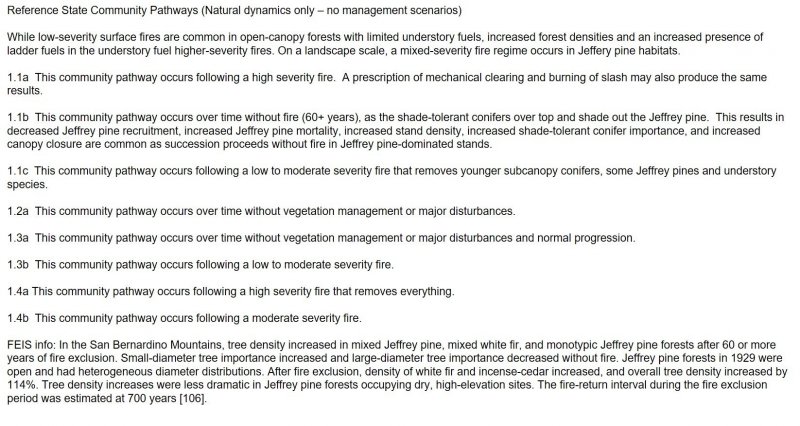Ecological site group F019XG916CA
Sandy Hills >30"ppt
Last updated: 07/06/2023
Accessed: 12/19/2025
Ecological site group description
Key Characteristics
- located on hills
- sandy texture
- >30" ppt
Provisional. A provisional ecological site description has undergone quality control and quality assurance review. It contains a working state and transition model and enough information to identify the ecological site.
Physiography
This ESG is found primarily on sloping to steeply sloping mountains within the San Bernardino Mountains at elevations between 5,400-9,800 .
Climate
The average annual precipitation in this MLRA is 23 to 98 inches (585 to 2,490 millimeters), increasing with elevation inland. Most of the rainfall occurs as low-intensity, Pacific frontal storms. Precipitation is evenly distributed throughout fall, winter, and spring, but summers are dry. Snowfall is rare along the coast, but snow accumulates at the higher elevations directly inland. Fog is a significant variable that defines this MLRA from other similar MLRAs. Summer fog frequency values of greater than 35% are strongly correlated to the extent of coast redwood distribution, which is a primary indicator species in this MLRA. Nightime fog is approximately twice as common as daytime fog and seasonally, it reaches its peak frequency in early August, with the greatest occurrence of fog from June through September (Johnstone and Dawson 2010). The average annual temperature is 49 to 59 degrees F (10 to 15 degrees C). The freeze-free period averages 300 days and ranges from 230 to 365 days, decreasing inland as elevation increases.
Soil features
Jeffrey pine typically grows on shallow, rocky, infertile soils and survives on dry pumice and bare granite substrates. About 80% of Jeffrey pine's distribution occurs on volcanic and granitic parent materials.
A representative soil for this ESG is the Pacifico soil within the San Bernardino National Forest soil survey, which is a mixed, mesic, shallow Typic Xeropsamment.
Vegetation dynamics
The structure of the Jeffrey pine forest varies over its distribution. A single tree layer is characteristic of Jeffrey pine stands on moderately dry sites, giving an impression of openness, limited leaf area, light, and heat. On moist and mesic sites a second tree layer exists which is composed of deciduous hardwood species, whereas on dry sites evergreen hardwood species form the second tree layer. Conifer species provide the second tree layer on xeric sites. The single (or upper) tree layer ranges from 30 to 50m (98 to 164 ft) in height, but in some stands this layer may exceed 65 m (213 ft). The second tree layer, where it exists, varies from 5 to 10 m (16 to 33 ft) in height. Complete (100 percent) crown cover is seldom encountered in Jeffrey pine habitats. Most stands have typically between 40 and 70 percent crown cover in the uppermost tree layer and usually less than 50 percent crown cover in the second layer, except on moist sites where Aspen cover may approach 100 percent.
A sclerophyllous shrub layer is common to most Jeffrey pine stands except on serpentine soils, extremely xeric sites where the shrub layer is absent (Jenkinson 1980), and where the krummholz form exists. Height and crown cover of the shrub layer varies with site characteristics. For example, taller shrub layers up to 2 m (6 ft) with significant crown (>70 percent) are common on more mesic sites.
The shrub layer of Jeffrey pine stands in southern California is dominated by scrub oak, ceanothus, Sierra chinquapin, manzanita, Parish snowberry, and cherry. Herbaceous species common to the Jeffrey pine type in southern California include rockcress, birdbeak, buckwheat, fritillary, groundsmoke, ivesia, lupine, rock melic, Bridge's penstemon, penstemon and needlegrass.
Information from:
California Wildlife Habitat Relationships System
California Department of Fish and Game
California Interagency Wildlife Task Group
Jeffrey Pine Joe R. McBride
Major Land Resource Area
MLRA 019X
Southern California Coastal Plains and Mountains
Subclasses
Correlated Map Unit Components
23481916, 22673550, 22673803
Stage
Provisional
Contributors
Curtis Talbot
Click on box and path labels to scroll to the respective text.

